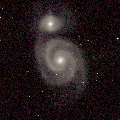
|
2MASS Large Galaxy Atlas: Introduction and Overview |

|
Nearby galaxies represent a unique laboratory set for detailed study of the largest objects in the Universe. The 2MASS Large Galaxy Atlas provides the necessary sensitivity and angular resolution to examine the diverse stellar populations, large-scale structures such as spirals, bulges, warps and bars, star formation regions and evolution of galaxies. This image atlas represents the first uniform, all sky, view of galaxies as seen in the near-infrared wavelength window that is most sensitive to the dominant mass component of galaxies.
Go to the Index of Galaxies
What's New (release 2.0)
Introduction
The 2MASS Extended Source Catalog (XSC) includes all resolved galaxies, regardless of their size, but does not accurately record the integrated flux for the largest galaxies due to their proximity to a "scan" edge. A typical 2MASS survey scan is 8.5 arcmin X 6 degrees, with 10% overlap between scans. Galaxies that are smaller than the overlap, D~50 arcsec, are guaranteed to be fully sampled in at least one survey scan. Larger galaxies may be truncated based on their proximity to a scan edge. Therefore we have constructed an atlas of large galaxies made from "pieces" of adjoining scans. The atlas consists of galaxies ranging in size from 2 to 30 arcmin, with a typical resolution of ~3 arcsec (w/ 1 arcsec pixels) in the 2MASS IR bands (J, H, Ks). The completed atlas provides the aggregate flux for each galaxy and a detailed view of the infrared morphology. The atlas is available to the public and can be accessed through the NASA Extragalactic Database (NED) and the Infrared Science Archive (IRSA).
The Large Galaxy Atlas represents a valuable asset to the professional and amateur astronomical communities. The near-infrared forms a natural, complementary, bridge between the well-studied optical wavelengths (e.g., POSS and SDSS) and the longer (e.g., Spitzer, IRAS, ISO, NVSS, FIRST) wavelengths. The near-infrared is most sensitive to the older stellar populations — the dominant mass component in most galaxies. Hence, the Large Galaxy Atlas is an ideal data set to combine with imaging data at other wavelengths. It provides a clear contrast between the underlying mass component and, for example, star formation regions as seen in the optical or mid-infrared bands. In addition, the atlas functions as an astrometric "finding" chart/map for both professionals and amateurs searching for supernovae in galaxies.
Why the infrared?
Most of the stellar mass in a typical galaxy is locked up cool stars, whose light is emitted longward of 1 micron ("redder" than the optical window). The spectrum tends to peak around 1.6 microns, corresponding to the H-band near-infrared (NIR) window:
In contrast, the optical spectrum (~0.5 to 0.8 microns) is dominated by the less-numerous (but more luminous!) early type stars — providing a window to sites of massive star formation. The mid-infrared (MIR) spectrum (5 to 30 microns) is dominated by photospheric emission from late-type stars (for elliptical galaxies; denoted in orange in the spectrum) and broad ISM emission bands (from dusty spirals; denoted in blue in the spectrum). Due to the uniform and symmetric distribution of the older stellar population in galaxies, as well as the minimized effects of extinction, NIR images appear much "smoother" than those of the optical or mid-infrared. 2MASS images provide a clear contrast with the optical/MIR, framing the underlying stellar population against the luminous (high-mass) star formation. A striking comparison between the NIR and the optical/MIR can be seen for the nearby face-on spiral, M83:
- M83: NIR + MIR; here we have combined the 2MASS J and K bands (blue and green, respectively) with the ISOCAM LW2 band (5.5 to 8.5 microns, centered on a prominent PAH emission band; denoted with a red halftone). Note the smooth NIR light (blue-green) compared to the clumpy MIR light (red). The MIR data was kindly provided by Alessandra Contursi.
- M83: optical; as seen in the 0.44 micron optical blue band (A&A, 1999, 345, 59L). As with the MIR, the spiral arms are illuminated by sites of massive star formation (e.g., GMCs & HII regions), while extinction is readily apparent with the dark dust lanes.
Additional IR spectroscopy of galaxies can be viewed in this educational page. For more general information on infrared astronomy, check out the excellent IPAC outreach site.
How are the mosaics constructed?
- Image Construction (take the M31 & M33 challenge!)
- 3-Color Rendering & Presentation
What is in the ATLAS?
- Basic Measurements
- Key to output table (position, photometry, ... etc)
ATLAS
Science Results
Links
- LGA homepage
- Flux Conversion & Calibration
- Infrared Galaxy Morphology (Jarrett, T.H., 2000, PASP, 112, 1008.)
- NASA Extragalactic Database (NED)